Evästeet
EvästeetLinkki avautuu uudessa välilehdessä
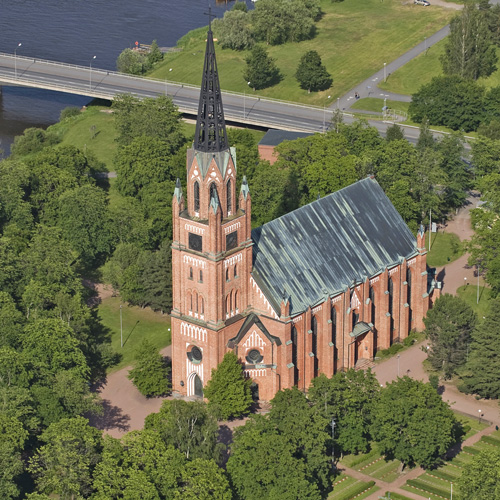
Hallituskatu 1 a, 28100 Pori
044 730 9637 Tilavaraukset , kasteet,häät ym seurakuntatoimisto
044 730 9636 Tilavaraukset , kasteet,häät ym seurakuntatoimisto.
1700
Tiekirkkona avoinna 26.6.-31.7.2023
• ma-pe klo 10-18
• oppaana Pirita Kukkonen
Keski-Porin kirkko on yli 160-vuotias. Häät sekä kasteet ja erilaiset konsertit onnistuvat kirkossa.Myös voit tulla itsenäisesti tutustumaan kirkkoon aukiolo aikana. Vahtimestari 044 730 9640 varmimmin ma-pe 10-13 esittelee myös kirkkoa.
Kirkossa on säännöllisesti seurakunnan järjestämää toimintaa, joista voi mainita tiistaisin sanan ja rukouksen ilta 18.30 , ehtoollishartaus (30min) keskiviikkoisin klo 12 sekä sunnuntaisin ja arkipyhinä jumalanpalvelukset klo 10.
Lyhyt kirkon esittelyvideo löytyy täältäLinkki avautuu uudessa välilehdessä.
_________________
In English: Choose ”Näytä lisää” and scroll down...
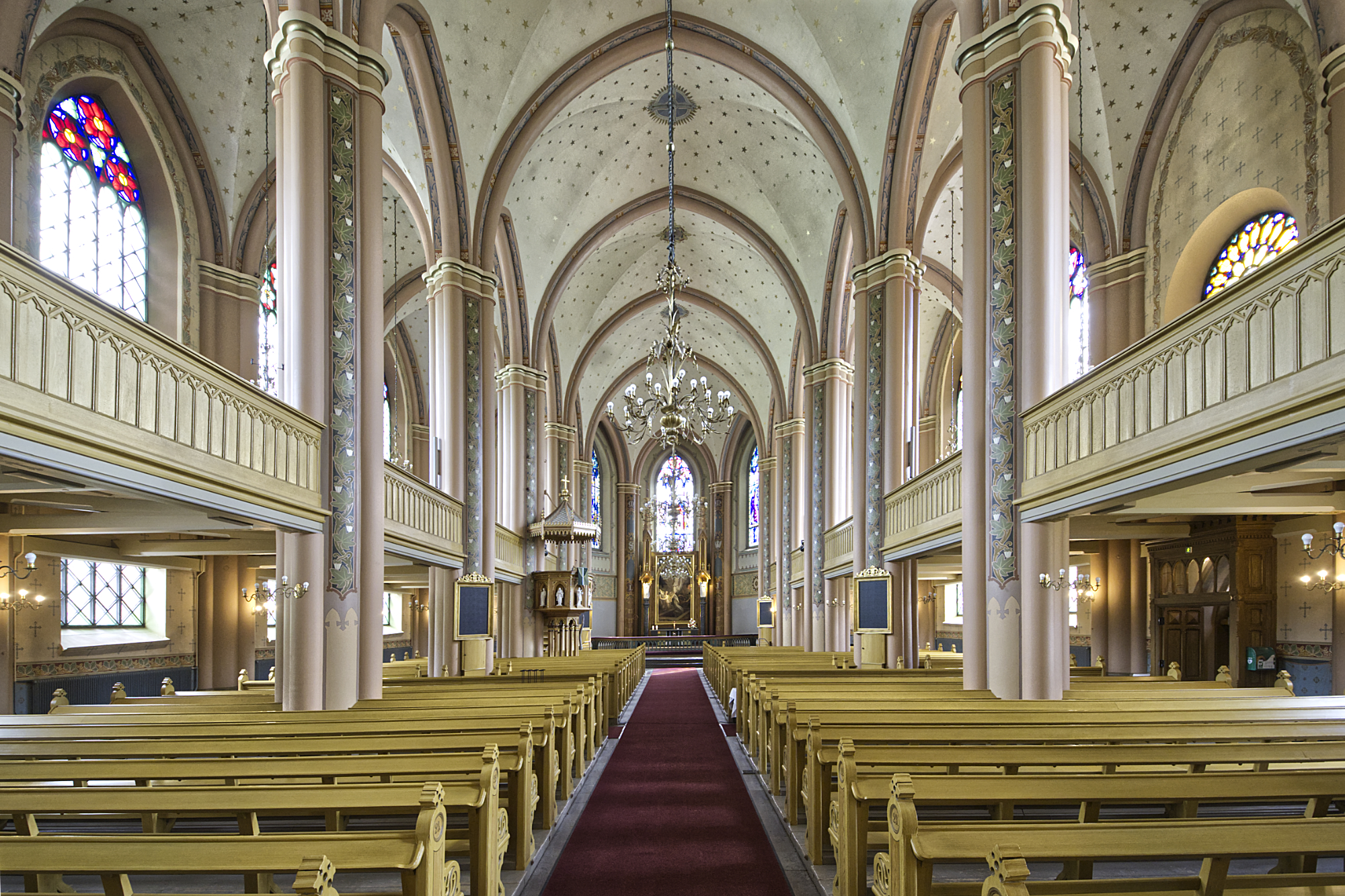
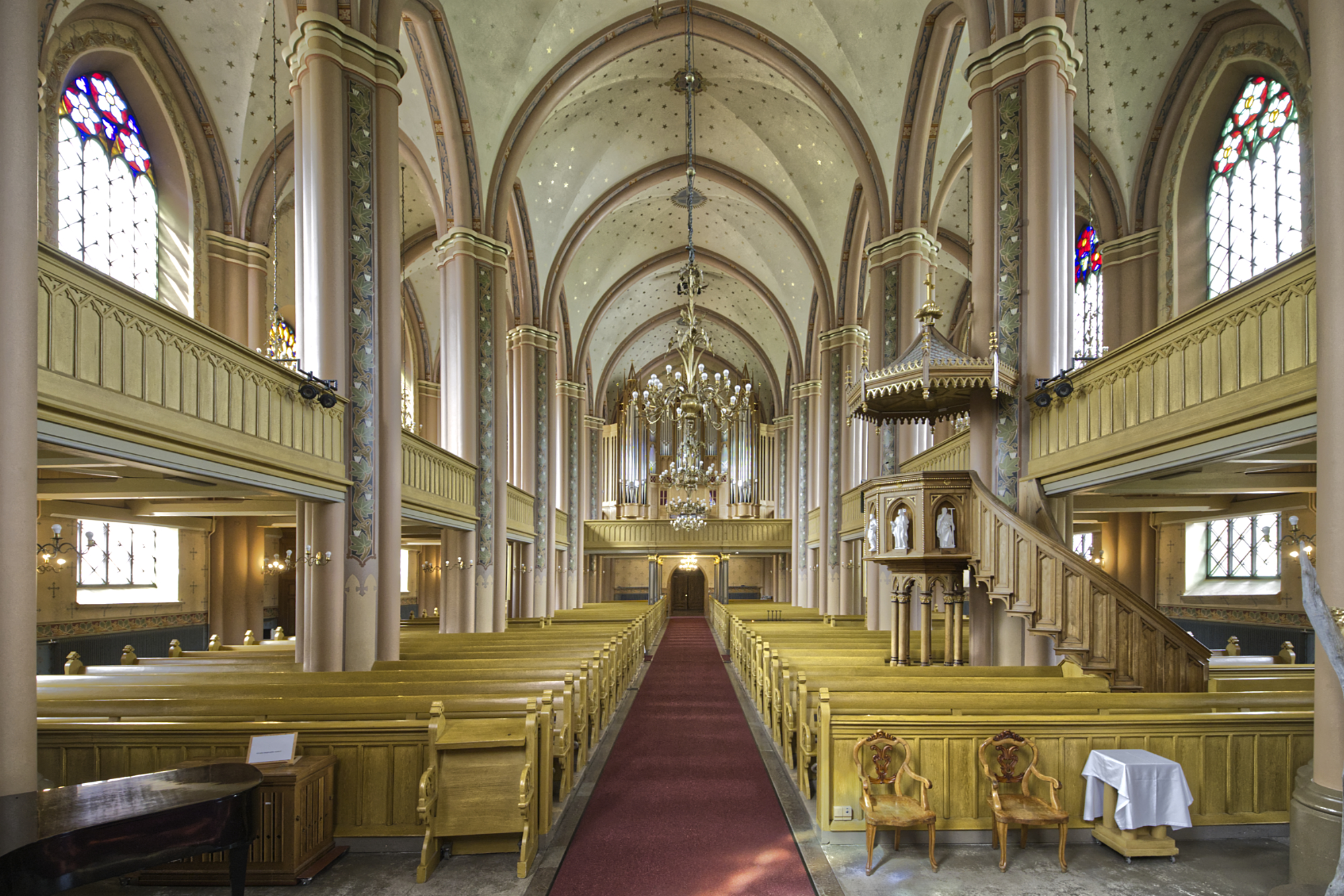
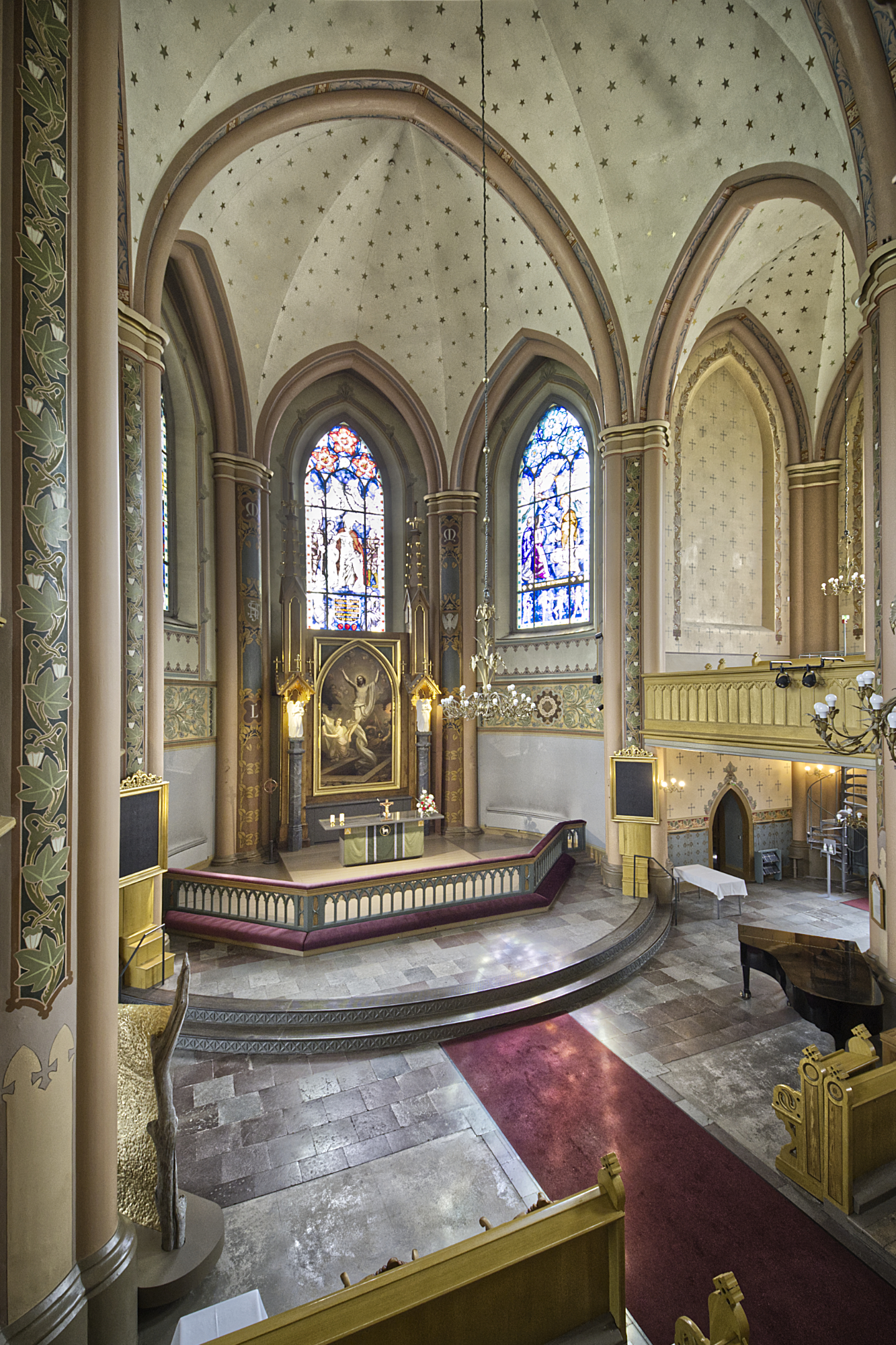
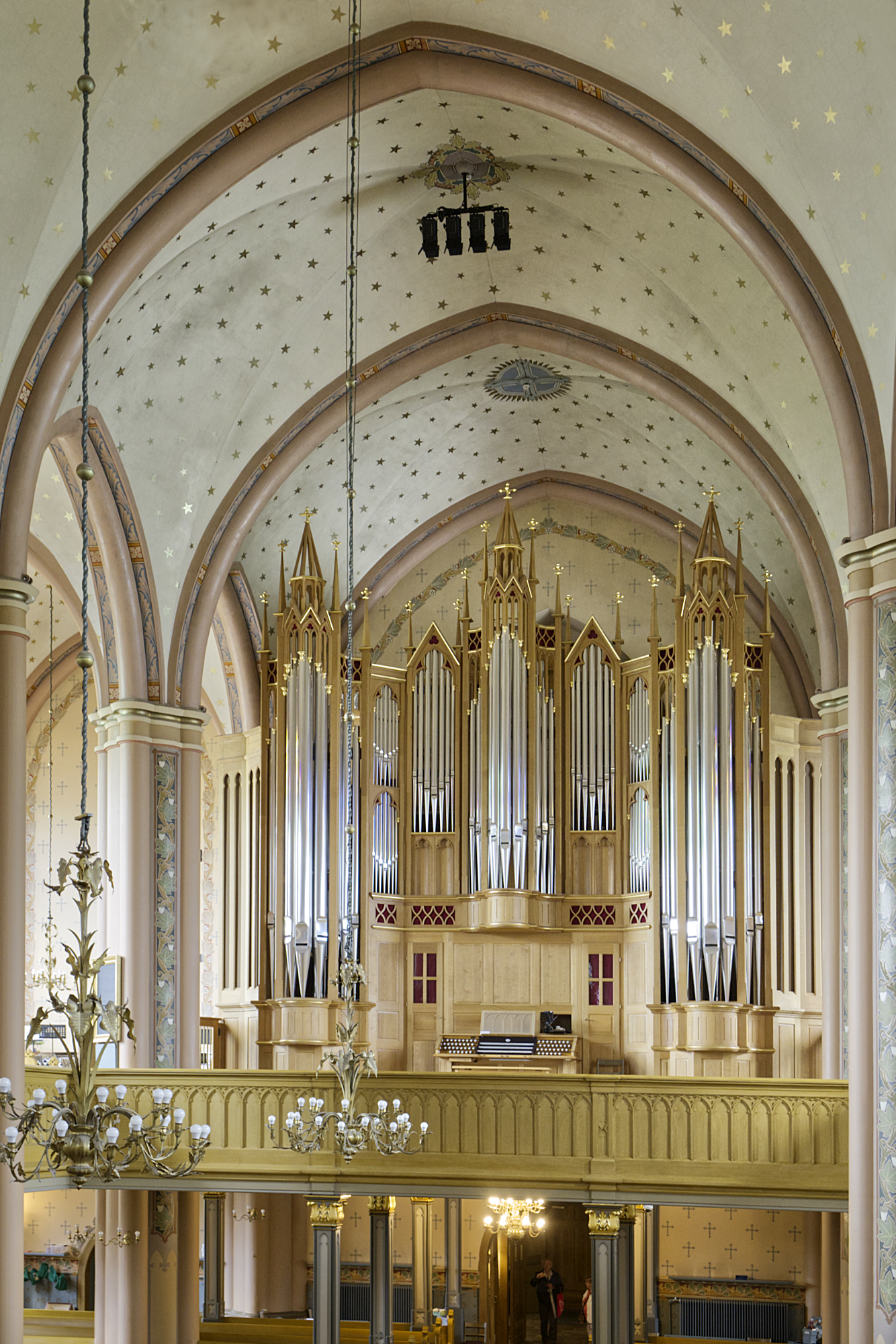
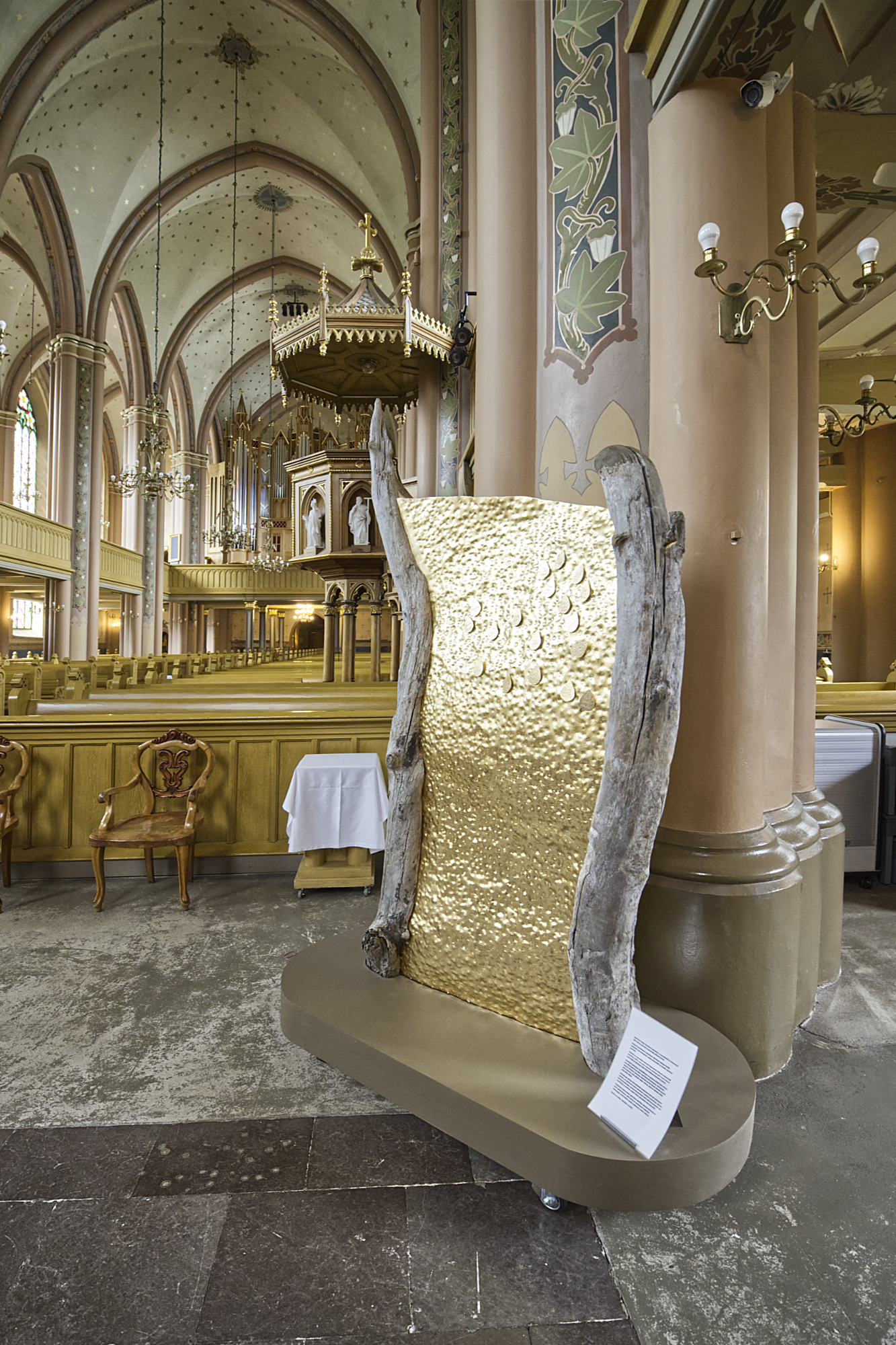
Keski-Porin uusgoottilainen tiilikirkko rakennettiin vuosina 1859–1863 Carl Johan von Heidekenin piirustusten mukaan. Kirkon sisustuksen ja Suomessa harvinaisen valurautaisen torninhuipun suunnitteli Georg Chiewitz.
Tornin huipun sekä ikkunapuitteiden valutyöt teki Porin konepaja. Lattian kalkkikivilaatat ja lehterin portaikkojen kivet tuotiin Öölannista, muuraukseen tarvittava kalkki Gotlannista. Valurauta tuotettiin Englannista. Kattopelti ja naulatkin olivat tuontitavaraa.
Ylösnousemusta kuvaavan alttaritaulun maalasi Robert Ekman vuonna 1863. Noin 30 vuotta myöhemmin August Krook viimeisteli kirkkosali jugendtyyliseksi. Kirkon interiööri on harvinaisuus, sillä 1800-luvun lopun kertaustyylistä kirkkoarkkitehtuuria on säilynyt vain vähän. Kirkkoon mahtuu 1700 henkilöä. Harvinaiset ovat myös kuorin lasimaalaukset vuodelta 1925. Taitelija Magnus Enckell valvoi Pariisissa lasin polttoa ja värivalintoja, mutta ei ehtinyt nähdä työtään valmiina. Lasimaalausten aiheet ovat ”Ilmoitus”, ”Jeesus Lohduttaja” ja ”Ylösnoussut”.
Kirkossa on lukuisia ristisymboleita: Tutuimman eli latinalaisen ristin ohella löytyy vaakatasossa olevia kreikkalaisia ristejä on muun muassa saarnatuolin päältä ja alttaripylväiden yläosasta. Apilanlehtiristit jämäköittävät penkkien päätyjä ja tyylitellyt, lehvistä koostuvat ristit kiemurtelevat seiniä pitkin. X-ristit koristavat alttarin puolikaaren muotoista porraskaidetta. T:n muotoinen risti on yhdellä saarnatuolin apostolilla.
Kirkko peruskorjattiin vuosina 1995–1996. Sen jälkeen käyttöön saatiin varta vasten Keski-Porin kirkkoon suunnitellut kirkkotekstiilit. Samettiset silkillä ja silkkilangoilla kirjotut tekstiilit suunnitteli Raija Rastas.
Ranskalais-romanttista sinfonista urkutyyliä edustavat urut valmistuivat vuonna 2007. Paschen Kiel Orgelbau -urkurakentamon soittimessa on 58 äänikertaa. Uruilla on tehty lukuisia levytyksiä, vuosittain kesäkuussa järjestettävä Pori Organ -festivaaliLinkki avautuu uudessa välilehdessä tuo Poriin huippu-urkureita eri puolilta maailmaa.
Keski-Porin kirkkopuiston sankarihauta-alueen muistomerkki vuodelta 1952 on Aimo Tukiaisen tekemä. Siinä on 25 metrin pituisella graniittijalustalla kuusi veistosta.
Kirkon vahtimestarin puhelinnumero on 0447 309 640.
Central Pori's neo-Gothic brick church was built in 1859-1863 according to Carl Johan von Heideken's blueprints. The interior decoration and the cast iron top of the tower, which is quite rare to Finland, were designed by Georg Chiewitz.
The top of the tower and the window frames were cast by Porin konepaja foundry. The limestone tiles and the stones for the loft staircases were imported from Öland and the calcareous material needed for building was imported from Gotland. The cast iron was bought from England. The roof's metal sheets and nails were also imported.
The altarpiece depicting the Resurrection was painted by Robert Ekman in 1863. About 30 years later, August Krook added finishing touches to the church hall in Art Nouveau style. The interior of the church is a rarity be- cause most of the church architecture in the post-neoclassical style from the end of the 19th century did not survive. The church seats 1 700 people.
The glass paintings in the apse, dating from the year 1925, are also rare. Artist Magnus Enckell supervised the burning of glass and colour selections in Paris but he did not live to see the finished work. The themes of the glass paintings are "The Announcement", "Jesus The Comforter" and "The resurrected".
There are numerous cross symbols in the church: In addition to the most common one, the Latin cross, there are horizontally placed Greek crosses for example on top of the pulpit and at the top part of the altar pillars. Shamrock crosses give a sturdy image to the ends of the benches and sty- lised, sprigged crosses coil on the walls. X-shaped crosses decorate the half- circle shape of the altar's railing. One apostle on the pulpit carries a T- shaped Greek cross.
The church was renovated in 1995-1996. After that, church textiles desig- ned specifically for Central Pori Church were taken into use. The velvety textiles embroidered with silk and silk threads were designed by Raija Rastas.
The organ, representing the French romantic symphonic style, was manufactured in 2007. The german organ manufacturer Paschen Kiel Orgelbau made this instrument with 58 ranks. The organ has been used for several recordings, as the annual Pori Organ festival, organised every June, brings to Pori top organists from different parts of the world.
The memorial, dating from 1952 and located in the soldiers' grave area of Central Pori Churchs garden was made by Aimo Tukiainen. The memorial has six sculptures on a granite pedestal of 25 metres.
Paschen Kiel Orgelbau GmbH 2007
When the new organ for Central Pori Church was being planned, two main objectives were in the forefront: firstly, to provide the congregation with a versatile and inspiring instrument and secondly, to build an organ of the highest artistic integrity based on the French Romantic tradition.
Organ building prospered in France in the second half of the 19th century. This resulted in a number of brilliant instruments being built in different parts of France, during that period. The inspiration provided by the new style of organ-building, culminated in a significant output of major organ-compositions being created. The most important composers of this style are César Franck, Louis Vierne, Camille Saint-Saëns, Alexandre Guilmant and Charles-Marie Widor.
The organ in Central Pori Church was built by the German organ-building company, Paschen Kiel Orgelbau GmbH. The specification, designed by the Parisian organ specialist Kurt Lueders, has 58 stops on three manuals and pedal. The organ-builders and voicers, Helmuth Gripentrog and Kalevi Mäkinen, were responsible for the voicing of the organ.
The organ façade was designed by Roland Monczynski, Director of the Paschen Organ Factory, who based the design on a combination of the typical characteristics of the French Romantic organ style, with that of the Neo-Gothic architecture of Central Pori Church. The casework and façade is made of oak and houses selected front pipes belonging to the stops Montre 16’ and Montre 8’, both of which are part of the division “Grand Orgue “. The remainder of this division, belonging to the main manual is located behind the façade. The Positif and Récit divisions are enclosed in swell boxes, one on top of the other, behind the Grand Orgue division. The pedal pipes are on both sides of the Grand Orgue division. The largest pedal stops, Soubasse 32´ and Bombarde 32´, are situated at the back wall of the organ case on their own wind chests.
The tonal structure of the organ specification is based on the French Romantic organ tradition and is for this reason, that the instrument’s sound reflects the quality of timbre embodied in a symphony orchestra. Emphasis is on fundamental tone, which is in turn shaped by juxtaposing and the combination of three characteristic stop families (flutes, strings and the numerous colourful and brilliant reed stops). In addition, the first and second manuals include a fully-fledged mixture chorus, e.g. Grand Orgue( the first manual): Montre 16´, Montre 8´, Prestant 4´, Doublette 2´, Fourniture 5r, Cymbale 4r. Additionally the organ has colourful mutation ranks, for example Nasard 2 2/3’ or Tierce 1 3/5’.
All departments of the organ are subdivided into two sections: foundation stops and forte stops. The latter may be prepared thanks to the appel system (foot activated pedal-levers which bring on the previously-drawn stops belonging to this group). In addition to the appel pedals, the organ also possesses a computer-based register memory system, which enables the recording of a nearly countless number of stop combinations.
The pipes of the second and third manuals are enclosed in wooden chambers known as swell boxes, whose sides can be opened and closed progressively to increase and decrease the volume of tone. In addition to the usual couplers, e.g. second to first, the first and third manuals are equipped with suboctave couplers (Octaves graves). All of these devices make great dynamic variation possible; the organist can thereby initiate tremendous crescendo and diminuendo effects.
The tracker action of the organ is mechanical, and the stop action is both mechanical and electrical. All the manuals are equipped with the so-called Barker lever machines to assist the keyboard playing action by means of pneumatics. This way the fundamental principles of mechanical action and those of pneumatic action conjugate most effectively. The mechanical action retains a clear pluck point, without the touch being influenced by the couplers, thus giving the organist the means to control this technically complex late Neo-Romantic organ with all its couplers, double pallets and long action runs, in a musical and sensitive way.
The wind system (12 large bellows), the console design, pipework placement, scaling and voicing were carried out in accordance with the essential characteristics of the French Romantic organ building tradition.
Helmuth Gripentrog
Kalevi Mäkinen
Translation:
Leena Tuomola and Andrew Plumridge
 Esteetön kulku
Esteetön kulku Pysäköinti
Pysäköinti wc
wcHallituskatu 1 a, 28100 Pori
Hallituskatu 1 a, 28100 Pori
Hallituskatu 1 a, 28100 Pori
Hallituskatu 1 a, 28100 Pori
Hallituskatu 1 a, 28100 Pori
Hallituskatu 1 a, 28100 Pori
Hallituskatu 1 a, 28100 Pori
Hallituskatu 1 a, 28100 Pori
EvästeetLinkki avautuu uudessa välilehdessä